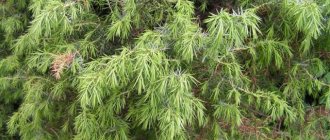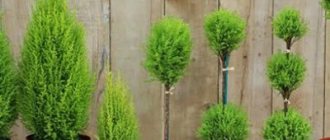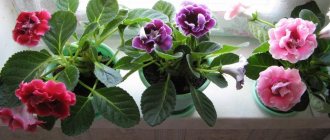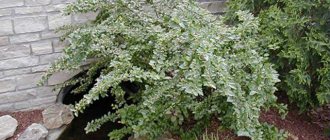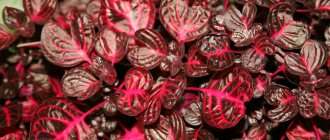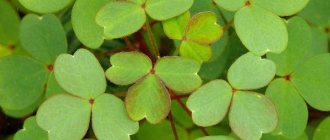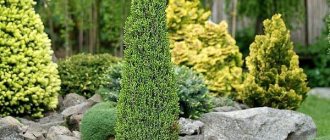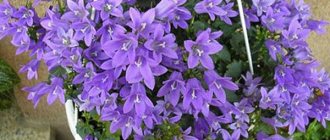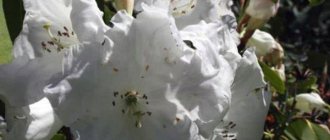Planting and caring for cypress
- Flowering: decorative deciduous plant.
- Lighting: in the morning - bright diffused light, in the afternoon - partial shade (eastern and northern window sills).
- Temperature: 20-24 ˚C in summer and 5-15 ˚C in winter.
- Watering: regular, moderate in summer, scanty (once a week) in winter.
- Humidity: normal for residential premises.
- Fertilizing: in the spring-summer period - once a month with mineral fertilizers in a concentration twice as weak as recommended.
- Replanting: once every two years in April or May.
- Reproduction: seeds and cuttings.
- Pests: scale insects, false scale insects and spider mites.
- Diseases: due to improper maintenance and care, the needles turn yellow and dull, the branches dry out, and sometimes root rot develops.
Read more about growing cypress below.
plant (lat. Cupressus) belongs to the genus of evergreen shrubs and trees of the Cypress family with a spreading or pyramidal crown shape. The genus is so ancient that perfectly preserved remains of its representatives are found in strata of the Tertiary period. Today, according to various sources of information, the genus numbers from 14 to 25 species. Some researchers consider the Mediterranean to be the birthplace of cypress, others argue that these plants have long been found in the tropics and subtropics of North America - in California, for example, and cypress was brought to Europe from there.
But the legend about Cypress, a slender young man who killed the horse of the god Apollo and for this was turned into a tree, refers to the ancient Greek epic, which confirms the version of the Mediterranean origin of cypress. In nature, the cypress tree reaches twenty-five to thirty meters in height, but cypress grown at home is small in size, since it was bred specifically as an indoor cypress - a potted or tub plant.
- Caring for Mentas at home
Features of seasonal care
At different times of the year, agrotechnical measures and optimal conditions for growing cypress differ. Beginning flower growers often make the mistake of practically not changing temperature, watering, or humidity in the winter, which leads to weak plants and poor vegetation in the spring.
Helpful tips for every season:
- Spring and summer period. At the beginning of the growing season, the desired crown shape is formed: from pyramidal (traditional) to spherical (exotic). Some gardeners give an original look to such a “pliable” plant as Indoor Cypress. The photos show a variety of crown design options. Fresh air is useful: the plant is taken out onto the terrace, loggia, balcony, where it is not very hot. The optimal temperature is +20°C or more, but at +28°C...+30°C and above, you will have to move the pot with indoor cypress to an area with moderate temperatures. In hot weather, it is useful to spray the bushes and shade them a little with blinds.
- Autumn and winter period. At the end of November, the plant is moved to a cool room. It is important that the coniferous tree receives enough heat only in the summer, otherwise the cypress grows poorly without rest. Optimal indicators are at the level of +8°С...+10°С, as an exception, +13°С...+15°С are acceptable. You cannot keep shrubs near radiators on the windowsill. On an insulated balcony, cypress can stand all winter. Rags and foam are used to create a protective structure around the flowerpot so that the roots do not freeze. Watering is rare: once every 10 days is enough, the volume of water is small. As temperatures rise, the soil is moistened more often. Feeding is carried out no more than once every 6 weeks.
Botanical description
Decorative cypress, that is, cypress grown in a pot, differs from a tree or bush growing in nature, for example, in our Crimea, only in smaller size. The same shape, the same soft shoots, covered on all sides with scale-like leaves shaped like an elongated diamond. The color of the leaves is dark green with a bluish tint. The fruit is an ovoid cone with shield-shaped scales, under which cypress seeds are hidden.
Sometimes the home cypress (Cupressus) is confused with the similar cypress tree (Chamaecyparis), which has light green needles, but this does not harm either plant, since caring for the home cypress and the similar cypress tree is approximately the same. It is worth warning, however, those who want to grow cypress in their home that it is capricious and demanding.
Description of the plant
Cypress belongs to the genus of evergreen trees and shrubs of the same family. Forms a pyramidal or spreading crown. Young plants have small, needle-shaped leaves. In adult specimens they are scale-like, pressed against the branches. Cypress is a monoecious plant: under one crown there are male and female cones that ripen in the second year. Seeds are hidden on the underside of the cone scales.
Cypress trees are inhabitants of subtropical and tropical climates. Frost-resistant species are grown in gardens and parks, and large-fruited cypress is popular for growing at home in a pot.
In Christian culture, cypress appears as a symbol of eternal life and is mentioned in the Bible as a tree growing in the Gardens of Eden.
In order to arrange a piece of the Garden of Eden on your windowsill, the cypress needs to create conditions close to its natural habitat.
Caring for cypress at home
Growing conditions
Caring for cypress first of all means, as far as possible, recreating conditions close to natural. Cypress is a southern plant, so it needs good lighting - bright diffused light is best for it, but with shading in the midday hours. Eastern or northern window sills are the best place for cypress. In nature, cypress trees grow in the very sun, but only mature plants can withstand it, while young trees hide in the shade of large trees, and this saves them from the scorching rays of the sun.
A comfortable temperature for cypress in summer is about 20 ºC and above, and cypress needs to spend the warm season in the fresh air - at least on the balcony. Outdoor plants do not tolerate mustiness and stagnant air, therefore, if it is not possible to take the cypress into the yard or onto the balcony, provide fresh air access to the room where the plant is located. If the summer is hot, you will have to spray the cypress up to three times a day. It would be a good idea to give him a shower from time to time and keep him on a tray with wet pebbles or moss.
As the shoots grow, the cypress is pruned to give it the desired shape. Pruning is done in early spring, before the active growing season begins.
Cypress in winter
How to care for home cypress in winter? In winter, it is necessary to keep cypress in a cool room at a temperature no higher than 15 ºC, but it is better at 8-10 ºC. To grow cypress, it is very important to observe the signs of seasonality: it should be warm in the summer, cool in the winter. Therefore, wintering on a windowsill, under which there is a heating radiator, can destroy the plant. Find a place for the cypress on an insulated balcony or loggia, and if you are afraid of the roots freezing, insulate the flowerpot by wrapping it in rags or covering it with polystyrene foam.
- Alocasia - care, photos, types
How to water
From spring to autumn, cypress is watered abundantly; in winter, watering is reduced to moderate: the plant reacts painfully to both waterlogged soil and insufficient moisture, so with regard to watering it is best to follow this scheme: the warmer the room, the more often you need to water. For example, if the room temperature is +8 ºC, you need to moisten the soil once every 10 days, but if the room is warmer, +12-14 ºC, watering is carried out once every 5-7 days.
How to fertilize
During the active growing season - from May to August - cypress is fed monthly with liquid mineral fertilizer for indoor plants; in winter, feeding is carried out once every month and a half.
Cypress transplant
Young plants are replanted annually in the spring, in April or May; older cypresses are replanted less frequently, as needed. Since the root system of cypress trees does not tolerate any interference, much less disturbance of the earthen coma, replanting is carried out using the transshipment method: in other words, only the soil that is shaken off from the roots of the plant removed from the old pot is replaced.
The composition of the soil for cypress is approximately this: one part each of sand, peat and turf soil and two parts leaf soil. At the bottom of the pot, you first need to place a layer of drainage material a few centimeters deep, then a layer of fresh soil, on which the cypress root ball is installed, and then enough soil is added to the pot so that the pot is filled, but so that the root collar of the cypress remains above the ground.
Cypress transplant
Young, fast-growing cypress trees are replanted annually, between April and May. Adult specimens do not need annual replanting; this procedure is carried out with them as needed, when the cypress becomes cramped in an old pot.
Replant cypress in a pot at home with extreme caution, as it does not tolerate even a violation of the integrity of the earthen coma. Essentially, the plant is transferred to a larger container, carefully shaking off the soil along the edges of the earthen lump.
At the bottom of the pot pour drainage a few centimeters deep, a little sand and a soil mixture consisting of:
- 1 part sand
- 1 part peat
- 1 part turf land,
- 2 parts leaf or regular garden soil.
New soil is poured under the earthen ball in such a way that the root collar of the transplanted plant remains above the soil surface.
The cypress is placed in a new pot, trying not to spill soil from it, and the space between the roots and the walls of the pot is carefully filled with soil. The soil is lightly compacted and watered.
Cypress propagation in an apartment
Growing from seeds
How to grow cypress from seeds? Before planting, cypress seeds purchased in a store or collected must undergo stratification (cold treatment), for which they are kept in the refrigerator for 3-4 months. Before sowing, cypress seeds are soaked for 12 hours in warm water, or better yet, in a solution of root or epin. Then they are planted according to a 4x4 pattern in boxes with a mixture for coniferous plants, under which a two-centimeter layer of crushed bark is first laid as drainage.
Instead of soil mixture, you can use sand or sawdust to germinate seeds, but as soon as the seedlings appear, they will still have to be replanted in the soil. The box with the seeds should be kept warm and slightly damp, but at best only half of the seeds will germinate. When the seedlings reach 5-6 cm in height, plant the bushes in separate pots, trying not to bury the neck of the seedling in the ground, and care for them as described above: water, be sure to spray, feed, provide them with a bright place for growth and normal development . Over the course of a year, the bushes will grow to 20-25 cm.
Cuttings
You can grow cypress not only from seeds, but also from apical or semi-lignified cuttings obtained by pruning the plant. Select those of the segments that have a “heel”, remove the lower leaves from them, place them, like a bouquet, in a root solution for about one day, and then, having washed and powdered the cuts with crushed coal, plant the cuttings in a soil mixture for coniferous plants, deepening at 1/3 height. Now soak the soil well with moisture and cover each cutting with a three-liter glass jar. 2-3 times a week the jar will need to be removed for an hour or two to allow the cuttings to breathe. After a couple of months, the cuttings will take root.
- Adenium - care, photos, types
How to propagate a plant: use cuttings and seeds
There are two methods of propagation: seeds and cuttings. Both methods are in demand among flower growers. You can successfully grow cypress from seeds at home, guided by the following agrotechnical rules:
- The cypress fruit is an ovoid cone covered with scales. Seeds are extracted from it and sent for stratification, i.e. cold treatment. They are placed in the refrigerator for 90-120 days.
- Before planting, the seeds are soaked for 12 hours in a biostimulant solution (Kornevin). It will speed up the process of germination of seedlings.
- Plant the seeds in a box with a drainage layer and slightly moistened soil.
- The box is placed in a warm place until shoots emerge.
- Seedlings that have grown about 6 cm from the ground are transplanted into separate pots.
First shoots
If the seed method of obtaining new seedlings seems labor-intensive, you can use cuttings:
- The best time for cuttings is April, but shoots can be cut in summer and autumn. Experienced gardeners combine harvesting with the pruning procedure.
- Apical and semi-lignified cuttings are taken. They need to be cleared of the lower leaves and immersed in a biostimulator solution (Kornevin) for a day.
- Before planting, the cut is covered with crushed coal so that it does not rot.
- The cutting is buried one third into the soil.
- All that remains is to moisten the soil and build a greenhouse: for this, the seedling is covered with a three-liter jar. It is removed once every 2 weeks for 1-2 hours to ventilate and eliminate condensation.
- Rooting takes 2 months.
Cypress responds favorably to indoor cultivation; caring for it will certainly pay off with the plant’s high decorative value and a favorable atmosphere saturated with a light pine scent.
Pests and diseases
Of the pests, cypress is most often annoyed by scale insects or false scale insects, sucking the juice of the leaves, and spider mites, which arise due to dry air in the room. Both insects will die after spraying with Actellik solution (1-2 ml of the drug per liter of water). If the symptoms of the presence of pests do not disappear, repeat the treatment of the plant with the same preparation after a week.
Unlike cypress trees grown in the garden, diseases of home cypress are almost always associated with violation of the rules for maintaining and caring for the plant. Sometimes, due to chronic waterlogging of the soil, cypress is affected by root rot. In case of disease, the plant is transplanted into new soil, having previously removed all rotten areas, providing the cypress with good drainage and reducing the frequency of watering and the amount of moisture to normal levels for cypress.
Cypress dries
If the tips of your cypress leaves turn brown and dry, this is a sign that:
- the air in the room is too dry;
- you do not moisten the soil enough or water the plant with bad water;
- poor lighting in the room;
- the room is too cold.
Eliminate these reasons, and you will not have to complain that the cypress has dried out.
Sometimes cypress leaves turn yellow due to lack of nutrients in the soil. About
Care errors and their elimination
Cypress is a more capricious plant than geranium, monstera, violets, fern, cissus vine, but most problems arise due to ignorance or inaccurate adherence to simple rules.
The table contains information about the main errors, recommendations for restoring the healthy appearance and condition of the coniferous species:
| Problem | Causes | Elimination |
| Leaves turn yellow and dry | The room is too hot. Fluid deficiency: infrequent watering. Excess nitrogen fertilizers | Spray warm water on the needles more often during hot days, shade the cypress a little with the help of blinds if the heat lasts for more than a day. Use nitrogen-based fertilizing formulations sparingly |
| Rotting | Watering above normal. There are no drainage holes in the flowerpot. Spraying at moderate indoor temperatures | Stabilize the water regime. Spray indoor cypress only in hot weather, when the moisture from the needles quickly evaporates |
| Doesn't grow | Poor lighting. Rare feeding. Conditions were not met during the winter rest period. Poor soil. Excessive soil dryness. Tight flowerpot | Adjust the characteristics of growing coniferous species, create optimal conditions |
The most common symptoms are yellowing and dryness of the leaves. It is important to clarify in the table what factors provoke this problem and how to solve it.
Types and varieties
More recently, it was believed that cypress trees cannot be grown in ordinary housing, but there were flower growers who refuted this misconception. Conifers are increasingly becoming inhabitants of city apartments, not to mention the fact that in private houses with extensive galleries and terraces, cypress trees are one of the most popular living decorative elements. We will present to you the most famous species of the cypress genus, grown as indoor plants.
Arizona cypress (Cupressus arizonica)
A light-loving and drought-resistant species, reaching a height of 15 m in nature. The bark of young shoots is gray, old shoots are dark brown, peeling off over time. The leaves are finely pointed and gray-green in color.
Evergreen cypress (Cupressus sempervirens)
In the wild, only the horizontal form of this species is widespread. Drought-resistant, cold-resistant (if we are talking about short-term cold spells). The crown is pyramidal, the branches are short, ascending, tightly pressed to the trunk. Does not tolerate excess moisture. It has high decorative qualities and is widely used in garden design and indoor decoration.
It has two widely used varieties in culture:
- pyramidal cypress (f. pyramidalis, f. stricta) - with a very dense narrow pyramidal crown of ascending branches pressed to the trunk. The needles are arranged crosswise and pressed tightly against the shoots. The cones are round, 2-3 cm in diameter, similar to a small soccer ball;
- horizontal cypress (f. horisontalis) - its branches extend vertically from the trunk, and then rise upward, due to which a wide pyramidal crown is formed.
Lusitanian cypress or Mexican cypress (Cupressus lusitanica)
It is distinguished by a wide pyramidal crown and hanging branches. The bark is red-brown, the branches are tetrahedral. Sensitive to cold, does not tolerate dry soil and air.
Has many decorative forms:
- Bentham form (Benthamii) - the shoots branch in the same plane, and the needles have different shades - from lush green to bluish, the crown is narrow and regular in shape;
- blue form (glauca) - a variety with needles of a bluish hue and a coating of the same color on the cones;
- sad form (tristis) – columnar crown, flexible branches directed downwards;
- Knight's form (Nightiana) - similar to Bentham's form, but the needles are gray.
Cashmere cypress (Cupressus cashmeriana)
Brought from India, it is very demanding on air and soil humidity, but grows well in indoor conditions.
Large-fruited cypress (Cupressus macrocarpa)
The species most adapted to growing indoors. The crown is pyramidal, the trunk is erect, numerous branches extending horizontally from the trunk are covered with small scales of light or dark green leaves. The lower branches of large-fruited cypress are darker than the upper ones, the cones are 3.8 cm in diameter.
Weeping cypress (Cupressus funebris)
With a cone-shaped crown and long drooping shoots covered with gray-green needles. The cones are small - 1.5 cm long.
Sometimes the so-called swamp cypress, which is also a representative of the Cypress family, but belongs to a different genus - Taxodium, is mistakenly classified as cypress. Its correct name is taxodium birow, and it is not evergreen like cypresses, but a deciduous coniferous tree.
Kochia scoparia, or summer cypress, which belongs to the Chenopodiaceae family, has nothing in common with cypress trees. Its leaves only resemble the foliage of a cypress, but kochia is also not an evergreen plant.
Cypress in the house: signs and superstitions
Some interesting facts:
- The coniferous plant is a symbol of nobility, fortitude and the desire for success.
- Bright greenery gives a good mood.
- Cypress, planted along the perimeter of a summer cottage as a hedge, reliably protects the owners from the penetration of negative energy.
- The fact of the positive effect of the species on human health has been scientifically proven: coniferous plants secrete phytoncides, in the presence of which many harmful microorganisms have no chance of survival.
When growing indoor cypress at home, you will have to spend a lot of time and effort to create suitable conditions, but the efforts will certainly not be in vain. When the gardener pays attention to the needs of the plant in the home, a spectacular green decor appears, the beauty of which delights everyone who admires the coniferous species.
Video - instructions for pruning Cypress and recommendations for maintaining a coniferous plant at home:
What you need for planting
New Year's cypress in a pot suffers from lack of soil and dry air. In the summer, a tree that has successfully overwintered in a room begins to dry out and turn yellow. It can be transplanted into open ground as soon as the ground thaws.
Any plant is better in the open air than on the windowsill. Experienced gardeners take advantage of this by transplanting capricious azaleas and roses from pots into a garden with a lump of earth, and in the fall taking them back indoors.
The cypress tree will only have to be planted once - in the fall. There will be no need to bring it into the house, as it winters well under the snow. For planting, you only need a shovel and a little bit of any fertilizer: organic, mineral or organomineral.
Common varieties for growing in pots
Tradescantia - types of hanging plants Anderson, Zebrina and others
Cypress is one of the varieties of plants that feel good indoors. They can be used both for landscaping balconies and large rooms.
Cypress trees include 7 species, all of them grow in mountain forests, on sea coasts and in swampy areas. They tolerate waterlogging and cold well. These trees can reach a height of up to 25 m (pea-bearing cypress), some grow even higher than 60 m (Lawson's cypress). Breeders also developed low-growing varieties that do not exceed 5 m, some are classified as dwarf varieties - up to 1 m.
Beginners in growing this plant should give preference to low varieties, for example, the Baby Blue variety of cypress pea. You can also take the blunt cypress Nana Gracilis for the first time. Over time, these varieties can be planted in the ground, where they will continue to develop.
Lawson's cypress
The highest representative of the Kiparisovs is Lavsona. Some varieties are capable of reaching a height of up to 70 m. When growing them, they try to reduce the height by pinching off the growing point (crown).
Lawson's cypress
Popular varieties:
- Golden Wonder. Not a very tall tree (only 7 m), with a conical crown. The branches of the variety are very powerful, growing by 15 cm per year. The needles of young shoots are tightly pressed and have a golden hue. It grows poorly on poor soils and does not tolerate drafts. In landscape design it is often used for single plantings.
- Columnaris Glauka. A tree with a pyramidal crown shape, capable of growing up to 10 m. It develops quickly, shoots grow 20 cm per year. The needles are bluish or metallic in color, with the onset of cold weather the color changes to gray. An excellent option for landscaping a balcony or terrace.
- Elwoody. The Elwoodi cypress grows to a height of only 2 m. It attracts many with its compact crown shape, slightly drooping downwards. A striking feature of the Lawson Elwoodi cypress variety is the unusual shade of the needles - bluish-gray. Some inexperienced summer residents, confusing the varieties of plantings, call it Elwoodi cypress.
Lawson Elwoodi cypress
- Globoza. This is another low-growing variety, a representative of the Lawson species. It grows only 1 m in height. Due to the location of the branches (horizontally), it resembles a shrub with greenish-blue needles.
Dumb cypress
It is also called blunt-leaved. Many representatives of this species do not exceed the height mark of 2 meters. Among all the varieties, the most popular for growing in the Moscow region are:
- Drat (Drakht) is a shrub that grows in height from 1.5 to 2 m. Each year it can add only 5 to 10 cm in height. It has a compact conical crown shape. The needles have a grayish-green tint.
- Rashahib. A dwarf shrub with a spreading crown shape. The branches are not closed, so the crown looks loose. The shrub has a bright green tone, on which cones of brownish or reddish shades are located.
- Nana Gracilis is a low-growing shrub. The bush is capable of growing only up to 60 cm. It has a wide crown with a conical shape. An excellent option for growing at home, because... plant with beautiful dark green needles.
Cypress pea
The cypress tree grows up to 3.5 m in height and can reach 2 m in width. Growing it requires space and a lot of light. With prolonged shading, the needles lose their natural tone.
Some varieties:
- Filifera Nana is a pea-bearing cypress that can grow up to 2 m in height. In the first 10 years it reaches only 50 cm in height. The shoots are thin and form a falling crown. The branches slightly resemble greenish ropes.
- Boulevard is a variety of cypress, the tree of which grows only up to 2 m in height. It was bred specifically for small winter gardens, which use a mix of flowering plants and dwarf evergreen trees, including the Boulevard cypress (another variant of the Russian name for the variety).
Cypress Boulevard
- Sangold is a small spherical shrub. It can grow up to only 50 cm. It has gained popularity in home gardening thanks to its soft needles, which have a greenish-golden hue.
Cypress Boulevard
Evergreen (Cupressus sempervirens)
Evergreen cypress has scaly leaves that are located on the shoots. The location is non-standard - cross-opposite. The cones on cypress are large, with clearly visible tubercles. The needles are dark green in color and have a compact columnar shape.
Cashmere (Cupressus cashmeriana)
A medium-height plant with a pyramidal crown shape. The plant is very demanding on growing conditions. Temperature and watering regimes must be observed. For the winter, the tree must be moved from the balcony or loggia (especially open ones) to a heated room.
Large leaf (Cupressus macrocarpa)
It gained its popularity due to its unusual aroma – lemon. A striking representative of the species is the Goldcrest Wilma variety - a cypress with lime-colored needles. Despite the fact that it does not bloom or produce cones, it is still used in landscaping residential buildings, offices and plots.
Features of caring for this indoor flower
In gardening, cypress has proven itself to be a rather unpretentious plant, but in indoor conditions, cypress shows some capriciousness. So how can you care for it at home and can you keep it there?
A nuance immediately after purchase
In flower shops, cypress trees grow in transfer pots, inside of which there is peat. Most often, the plant is very cramped in such a container, and its root system just begs to come out. Therefore, an evergreen tree needs to be replanted as soon as possible. After purchasing, you need to wait 6-7 days and transplant the cypress into a new, convenient pot. The above time is necessary for acclimatization.
When purchasing cypress, be careful. Plants like Kochia and Taxodium are very similar to what you need. Kochia is not evergreen, and Taxodium, although a cypress family, is deciduous.
Trimming
Some gardeners are inclined to believe that it is undesirable to prune indoor cypress, since its crown does not grow in large volumes. But most still recommend pruning. Cypress, depending on the variety, can be given the following forms:
- Ball.
- Cone.
- Spiral.
ATTENTION! In the last version you need to try really hard to make it really beautiful. If you have no experience in this matter, then it is better not to take risks, otherwise the plant will look, to put it mildly, unspectacular.
Pruning is carried out in the spring, when the plant is completely dry. It cannot be sprayed before the procedure. Excess shoots are removed entirely (cutting them in half is prohibited).
If necessary, pruning can be done in the fall.
Lighting
Cypress loves light very much, but does not accept direct rays of the sun. The ideal option is year-round diffused lighting.
If your plant is on a windowsill on the west or east side, it will need to be shaded at certain times. Accordingly, in summer the cypress is not placed on the south window; it will only be good in this part of the house in winter.
Lack or excessive amount of light is harmful to cypress , as it will negatively affect the development and growth of the plant. In the first case, the branches will stretch strongly upward and crumble, in the second case they will turn yellow.
Temperature
When growing cypress at home, it is very important to observe seasonality. Consider the fact that the natural conditions of the plant are subtropical.
The optimal temperature for cypress in summer is 20-30 degrees Celsius. But in winter you need to create conditions of about 5-10 degrees Celsius. During frosts, the root system of the plant freezes completely.
How to plant?
Planting and care at home is a simple procedure. If you have already bought an adult tree, you only need to replant it after acclimatization. The pot should be 3-4 times larger than the root system of the plant. It is best to choose a clay container. In plastic pots, the soil dries out quickly and cools down in winter, which will negatively affect your pet.
You can also purchase seeds at a flower shop, or remove brown seedlings from a pine cone. The landing scheme in this case is as follows:
- Seeds are planted in wide bowls.
- After 14-20 days the first shoot appears.
- After 30 days, tiny cypress trees can be planted in permanent pots.
How to transplant?
Young specimens need frequent replanting. The procedure is carried out annually in late spring, but as it grows, the frequency decreases. Mature cypress trees are replanted only if necessary.
IMPORTANT! You need to replant very carefully and carefully, transferring the plant from one pot to another. The slightest damage to the root system will lead to the death of the cypress.
Subtleties of transplantation:
The container is selected several sizes larger than the previous one.
- A drainage layer must be placed at the bottom (expanded clay, shards, sphagnum moss or coals can be used). The layer is a couple of centimeters.
- Pour a small layer of soil.
- Replant the plant.
- Add the required amount of soil on top so that it does not touch the neck of the root.
